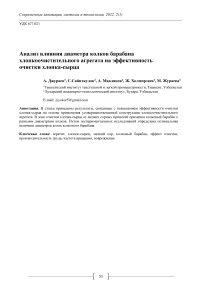Analysis of the diameter of the pins of the drum of a cotton-cleaning unit on the efficiency of cleaning raw cotton
Автор: A. Djuraev, S. Sayitqulov, A. Mavlyanov, J. Kholmirzaev, М. Jo'raeva
Журнал: Современные инновации, системы и технологии.
Рубрика: Машиностроение, металлургия и материаловедение
Статья в выпуске: 2 (1), 2022 года.
Бесплатный доступ
The article presents the results of increasing the efficiency of cleaning raw cotton based on the use of improving the design of the cotton cleaning unit. In the zone of cleaning raw cotton from small weeds, a peg drum with different diameters of the pegs was used. Experimental studies have determined the optimal value of the diameters of the peg drum pegs.
Aggregate, raw cotton, fine litter, chopping drum, cleaning effect, labor productivity, rotation speed, damage
Короткий адрес: https://sciup.org/14121916
IDR: 14121916 | УДК: 677.021 | DOI: 10.47813/2782-2818-2022-2-1-51-56
Текст статьи Analysis of the diameter of the pins of the drum of a cotton-cleaning unit on the efficiency of cleaning raw cotton
Today, the Republic of Uzbekistan is one of the world's leading cotton producers and exporters. It is therefore set up to buy cotton in the country. The production of high-quality fiber in line with world standards poses great challenges to specialists and scientists in the field of cotton processing in improving the existing technology. Its ever-increasing level of sophistication in spinning and weaving equipment necessitates greater safety concerns for the quality of cotton fiber.
Based on world experience, research is being conducted to improve the techniques and technology of weed control of raw cotton. In this regard, the development of effective technologies and equipment for ginning, achieving high efficiency of ginning, substantiation of operating modes and parameters are important tasks.Over the past five years, the country has taken comprehensive measures to improve the consumer properties of cotton products, the introduction of highly effective control systems for primary processing of raw cotton and technological processes of production. In this regard, significant results have been achieved due to the initial characteristics of production, especially in the production of high-quality fibrous products from raw materials processed in the initial processing of cotton, improvement of techniques and technology of cotton ginning. President of Uzbekistan Sh.M. Mirziyoyev signed Resolution No. PF-3408 of 17 October 2017 “On measures to radically improve the management system of cotton” “On cultivation and processing of raw cotton”.
It can be said that it was important to radically modernize the activities of clusters for the production and processing of raw cotton, ginning and processing enterprises. To perform these tasks, including:
One of the most important problems of cotton growing is the creation of new technologies of primary processing of raw cotton, improvement of cotton ginning technology and technology.
So far, the factors affecting the amount of fine and coarse contaminants in the process of cleaning raw cotton have been studied [1,2]. In particular, the frequency of rotation, parameters of the peg drum, grates, saw drum and others studied [3,4]. In the world market, the demand for maximum preservation of the natural physical and mechanical properties of fiber is growing. World standardization pays special attention to the appearance of the fiber and the amount of impurities in it, so it is important to increase the efficiency of cleaning cotton from small and large contaminants. At the same time, it should be noted that the disadvantages of the existing design of the machine for cleaning cotton from small and large contaminants (CCC) are that it separates fine wastes and combines with large contaminants separated from the cotton. In addition, the CCC cotton ginning machine does not have a sufficiently high efficiency in cleaning both fine and coarse waste. [5,6].
Taking into account the above, the experimental version of the improved design of the working bodies was carried out, taking into account the recommended parameters as a result of theoretical studies of the machine for cleaning cotton from small and large contaminants (CCC).
2. Materials and methods
The research was conducted in comparison with the current technology of cleaning cotton using cylindrical pegs and the recommended cleaning technology for the use of cylindrical piles of different diameters in the treatment of fine waste (figure 1).
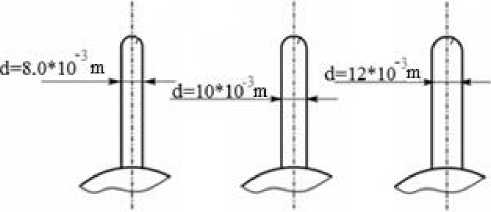
Figure 1 . Recommended cross-sections of pegs of different diameters.
The experiments were conducted in the following variants:
• existing technology for cleaning cotton from small wastes;
• technology for cleaning cotton from small debris using peg drums of different diameters.
3. Results and discussion
All samples were taken before and after the cotton ginning machine. Moisture, contamination, and cleaning efficiency were determined for each option. Indicators are obtained according to the state standard UzDst6432006, UzDst6442006, UzDst5922008. Moisture content of cotton was measured in the laboratory apparatus VXS-M1 using a laboratory scale VLKT. The cleaning effect was performed in the laboratory department of the LKM brand. Experimental specimens of pile drums of different diameters are shown in figure 2.
Analysis of existing research on the cleaning of raw cotton from small contaminants [7,8], as well as based on the analysis of our theoretical research, considering the use of peg drum of different diameters, we can consider the main functions of the improved cleaning machine.
Given the high density of the cotton pieces at the beginning of the cleaning process, it is important to effectively grind the cotton by having the first drum being the smallest diameter peg drum.
In the final cleaning zone, the cotton is more crushed and therefore the diameter of the drum pegs was taken the largest to be the largest for efficient transportation.
Unfortunately, the existing cotton ginning machine cannot fully perform the above functions. Technological experiments were conducted for the following options:
-
• existing peg drum;
-
• recommended peg drum of various diameters;
-
• еhe experiments were performed according to the above methods.
The results of the technological experiments are presented in the form of graphs in figure 3.
The analysis of the obtained graphical dependencies shows that when using the existing peg drum, the cleaning efficiency of the cotton ginning machine decreased to 37.5% at 5 t/s, and the cleaning efficiency decreased to 34.5% at 6 t/s. With the increase in work efficiency to 7.0 t/s, the cleaning efficiency decreased to 28.1%.
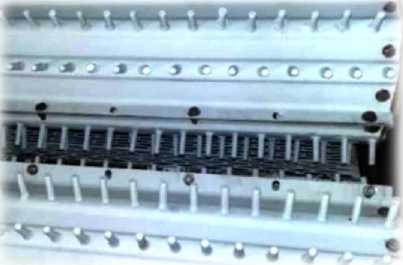
a - View of the cotton ginning zone using twelve mm diameter pegs drums.
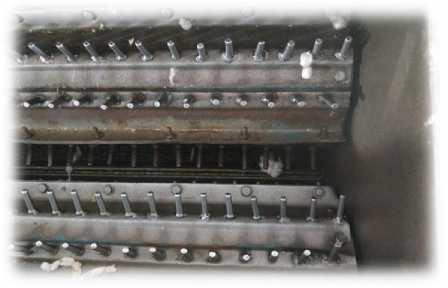
b - View of the zone using ten pegs drums.
cotton ginning mm diameter
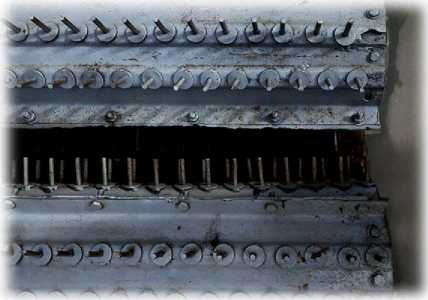
Figure 2. Appearances of peg drums with diameters of 8 mm (a), 10 mm (b) and 12 mm (c).
с - View of the cotton ginning zone using eight mm diameter peg drums.
When using a peg drum with a recommended diameter of 8 mm, the cleaning efficiency in grade II cotton is 40.5% if the work efficiency is 5 t/s, and the cleaning efficiency is 31.5% when the work productivity is increased by 7 t/s.
The analysis of the graphs showed that when using a 12 mm diameter peg drum, the cleaning efficiency of the ginning machine decreased to 32.2% at 5 t/s and to 28.3% at 6 t⁄2. (figure 3) As the work productivity increased to 7.0 t/s, the cleaning efficiency decreased to 23.8%.
A comparison of the results showed that the cleaning efficiency when using an 8 mm peg drum with the recommended diameter was higher in grade II cotton (3.0 ÷ 3.2)% than that available in a peg drum. This is because the smaller the diameter of the pegs, the smaller the piece of cotton will catches, i.e. the separation of the cotton into fibrous seeds will intensify. More fine waste is separated from them.
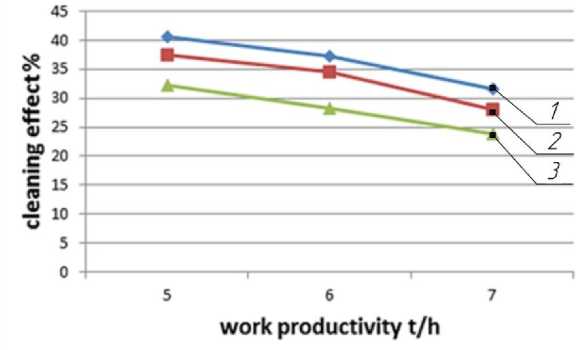
Figure 3 . Graphs of the dependence of the number of graphs on the cleaning efficiency (grade II cotton), which represents the effect on the cleaning efficiency of peg drums of different diameters in the cleaning of cotton from fine waste. 1 - 8 mm diameter peg drum (grade 2 cotton);
2 - available 10 mm diameter peg drum (grade 2 cotton); 3 - 12 mm diameter peg drum (grade 2 cotton).
4. Conclusions
On the basis of modernization of the unit for cleaning of raw cotton from small and large wastes, the cleaning technology using pegs of different diameters and multi-sided grate has been improved. Parameter values were based to ensure that the cleaning efficiency was high.

